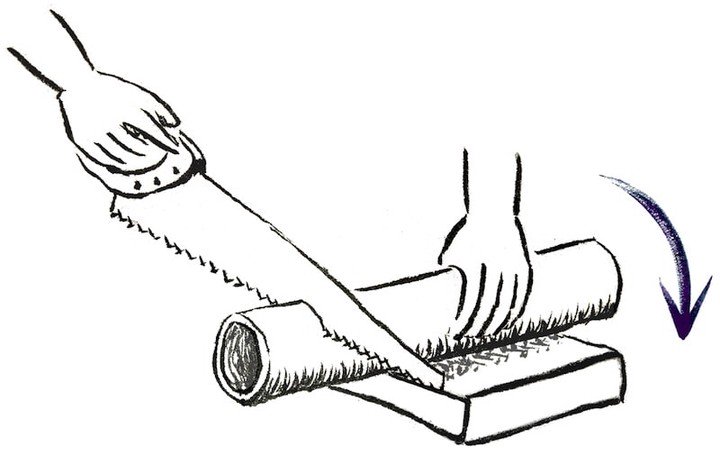How to saw bamboo into smaller sections?

Which kind of saw can I use to cut bamboo? How to immobilize the bamboo when sawing it? Is there any special trick for sawing bamboo?
Here is a short tutorial based on a video review of 7 highly skilled bamboo craftsmen from around the world.
This tutorial is part of my bamboo craft project, where I share tutorials, prototypes and resources for designing and building bamboo objects with simple tools.
Video review (2 min 30 sec)
Wear gloves for safety!
None of the skilled people showed in the video review wear safety gloves when sawing! However, it is probably a good idea to wear gloves if you are a beginner, at least one glove for the more vulnerable hand that is holding the bamboo.
It is indeed quite common for the saw to slide when starting or to jump when sawing. Even highly skilled people can actually injure themselves from time to time, as we can infer from the plasters they have on their hands! (see video)
Which kind of saw can I use to cut bamboo?
Almost any kind of woodworking or carpentry saw should work to cut bamboo.
Manual saws are totally suitable because bamboo is easy to saw as it is hollow. A small manual saw can be used for small diameter bamboo poles or precise works. Medium or big manual saws can be used for cutting bigger bamboo culms.
If the bamboo pole is particularly big, if you need to cut a lot of poles, or if you need to be very precise, an electrical saw can also be fine. Craftsmen use from small band saws to big circular saw blades.
However, jigsaws should probably be avoided as they are likely to detach the fibers of the outer layer of the bamboo culm.
Examples of saws used by craftsmen and craftswomen:








How to immobilize the bamboo when sawing it?
It is necessary to immobilize the bamboo to saw it properly and securely.
In the case of precise works, or for small bamboo pieces, it is possible to use a vise or a clamp. However, as bamboo is hollow, we need to make sure not to press too much on the bamboo pole to avoid splitting it.
A very common way is to immobilize bamboo between one hand and one support. This does not require any specific tool and allow some mobility, which can be useful for making clear cuts (see next section).

It is also common to see advanced craftsmen and craftswomen using not only one hand and one support but also one or two feet! It may require some trials and experience, though, to find a stable and comfortable sitting position.
Special trick: turning the bamboo when sawing for a clear cut
One of the specificities of bamboo is that its internode sections are made of parallel fibers which can be split from one another very easily. Hence, when the pressure of the saw goes from the inner side of the pole towards the outside, the outer fibers are likely to be detached.
To avoid splitting and make a clear cut, the most common technique seen among craftsmen is to turn the bamboo while sawing. This way, the saw will cut the outer fibers before they can split. Turning also helps to make a more even and perpendicular cut. There are different ways of applying this technique as you can see in the video review.

Besides, craftsmen appear to use generally push stroke saws, meaning that they cut when pushing the saw. They hence apply more strength when pushing the saw rather than when pulling. They tend to start slowly to initiate a precise cut, then accelerate, and then slow down again when reaching the last centimeters to cut. These techniques also help to make a clear and precise cut as well as avoiding splitting the outer fibers.
Happy sawing!
Did you enjoy this post?
Great! Then, you may also like to read how to split bamboo into flat slats, and how to drill bamboo.
References used in the video
- Japan - fushimiurushikobo, 2014, Making the rim of a small plate
- Myanmar - British Council Myanmar, 2015, From Craft to Art: Bamboo craft
- Thailand - Sammi Law, 2011, Thai Home Business_Chopping Bamboo
- Japan - fushimiurushikobo, 2008, Curry spoon,bamboo (from 1 to 6)
- Indonesia - R B, 2016, How to make a bamboo serving tray
- Georgia - TLC Channel, 2019, How to make bamboo chair beautiful | Bamboo Furniture making
- Taiwan - shengfenchien, 2009, bamboo chair (from 1 to 6)